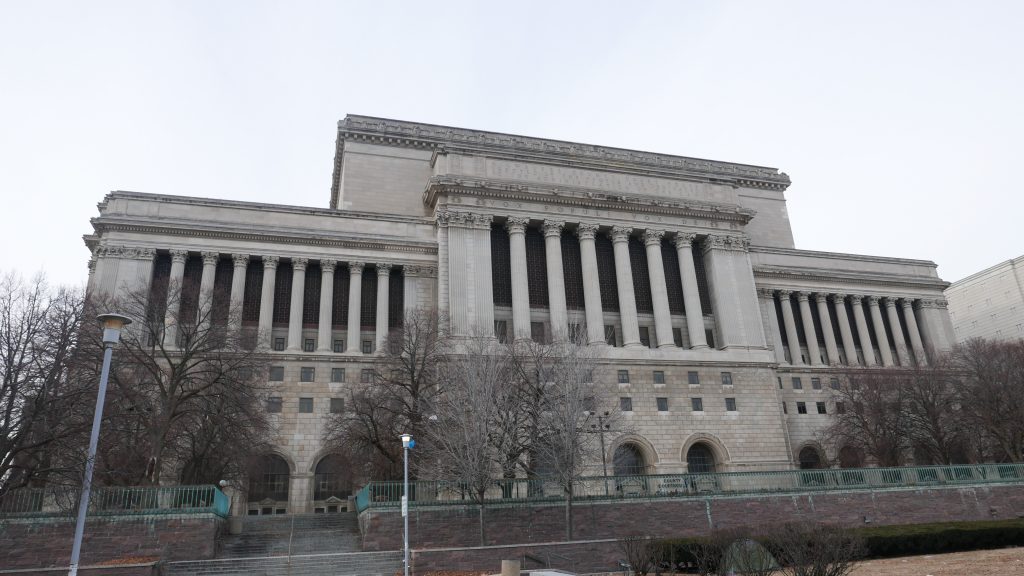County’s Financial Forecast Gets Grimmer
County falls short by more than $100 million in new five-year outlook by comptroller.

Milwaukee County Courthouse. Photo by Graham Kilmer.
A new analysis by the Milwaukee County Comptroller shows the county is heading for historic budget deficits in the coming years just as federal stimulus funding begins to run dry.
This prediction is not new. The comptroller and the county’s budget analysts have been regularly warning that the county is headed for a fiscal cliff, forestalled in recent years by a massive infusion of federal funds during the COVID-19 pandemic. But in just a year, the county has seen the prediction worsen. Between 2024 and 2028, the county is now expected to be short by $109.5 million.
This figure represents the county’s structural deficit, which is the cost to maintain county government as it exists today subtracted by the money the county will actually have to run the government. Last year, the comptroller put the annual structural deficit between 2023 and 2027 at approximately $17.4 million, or $87 million over five years.
To close the gap the county has to cut funding, find new revenues or some combination of the two, as CJ Pahl, financial services manager in the office of the comptroller previously put it. The county has services it must provide under state statute, and as it exhausts local revenues providing these services some of the county’s most important local assets, like transit and county parks, will be left without local funds, necessitating hard budget cuts.
In the 2023 budget, the county went with a combination of the two. But the new revenues the county used were, in part, one-time revenues that made the structural deficit in 2024 worse. That’s because these one-time revenues, as county officials call them, are what the sound like: once spent they cannot be counted on in the next year, leaving a gap to fill. Federal stimulus funds are an example of one-time revenue, which the county has been largely avoided spending on recurring expenses.
“In the 2023 budget, the County utilized such one-time revenues of approximately $8.9 million, which impacted the 2024 structural deficit roughly by the same amount,” the comptroller’s report notes. The county also cut funding to the transit system by approximately $4 million.
The county backfilled its budget gap in 2023 with $1.5 million in stimulus funding for corrections officer pay and $7.3 million in funds from an account used to pay down the county’s debt. This fund, called the “debt service reserve,” can also be used for financing new infrastructure and maintenance. The county has seen annual budget surpluses in recent years largely due to savings on health care and salaries as jobs go unfilled, as well as higher-than-estimated sales tax revenues. When the county finishes the year without spending all the money budgeted, those funds roll over into the “debt service reserve” to reduce the amount of debt for which county taxpayers are on the hook.
On top of structural budget troubles, the forecast notes that mounting investment losses in the county’s pension plan will lead to increased pension costs over the next five years.
Looking at the county’s overall imbalance between revenue and expenses — known as the structural deficit — the comptroller’s report offers this conclusion: “Without a resolution, the only way forward for the County is the perpetual cycle of annual expenditure reductions, continued reliance on one-time revenues, and deferring maintenance, all which will undoubtedly adversely affect the essential services provided to the community.”
Something the comptroller’s report didn’t include, because it is still speculative at this point, is an increase in the county’s local sales tax from 0.5% to 1.5%. Such an increase was included in Gov. Tony Evers’ budget, but it’s expected that the Republican-controlled state Legislature will strip the provision and, potentially, draft a separate piece of legislation for the sales tax proposal. County Executive David Crowley has been advocating for the sales tax increase as a tool the county can use to address the county’s structural deficit pulling it back from a fiscal cliff and reducing the county’s reliance on property taxes. A 1% increase could generate an estimated $180 million in the first year. Under Evers’ proposal half of those funds, or $90 million, would go to the City of Milwaukee.
Transit System
As Urban Milwaukee has previously reported, the Milwaukee County Transit System (MCTS) is positioned to be one of the hardest hit areas of county government when federal stimulus funding runs out in 2025.
“Transit Division is facing an unprecedented fiscal cliff in 2025, driven largely by increasing costs, farebox revenue that remains below pre-pandemic levels, and tax levy funding that is less than half what it was pre-2017,” the report states. It estimates that the transit system will need approximately $25. 1 million in new funding for 2025 to maintain its current service levels
Before the pandemic hit, in 2019, transit farebox revenues were down 16.6% from 2015 levels. The pandemic made that worse, and the comptroller’s report does not expect farebox money to return fast enough to make up for that drop any time soon.
Inflation
Inflation is making everything more expensive and this will affect the cost to maintain current government services and “will also likely reduce the level of services provided as the County balances the rising costs of providers with stagnant revenue,” the report noted.
What’s more, even services that don’t have their budgets cut may end up serving fewer people “as prices grow over time but state and federal revenues remain flat.”
Debt
The county blew past its self-imposed debt limit over the past year, with funding allocations for the new Forensic Science Center and the new Milwaukee Public Museum building. The county’s level of debt has been pushed above half a billion and will not return to the 2022 level ($436 million) until 2027.
Major infrastructure projects and maintenance are often financed with debt. Based on requests from county departments, there will be $1.1 billion in maintenance and infrastructure needs over the next five years. Much of that will likely be deferred if the county does not exceed its debt limit again and if no new revenue is secured.
Read the full comptroller report on Urban Milwaukee.
If you think stories like this are important, become a member of Urban Milwaukee and help support real, independent journalism. Plus you get some cool added benefits.
More about the Local Government Fiscal Crisis
- Mayor Johnson’s Budget Hikes Fees, Taxes In 2025, Maintains Services - Jeramey Jannene - Sep 24th, 2024
- New Milwaukee Sales Tax Collections Slow, But Comptroller Isn’t Panicking - Jeramey Jannene - Jun 28th, 2024
- Milwaukee’s Credit Rating Upgraded To A+ - Jeramey Jannene - May 13th, 2024
- City Hall: Sales Tax Helps Fire Department Add Paramedics, Fire Engine - Jeramey Jannene - Jan 8th, 2024
- New Study Analyzes Ways City, County Could Share Services, Save Money - Jeramey Jannene - Nov 17th, 2023
- New Third-Party Study Suggests How Milwaukee Could Save Millions - Jeramey Jannene - Nov 17th, 2023
- Murphy’s Law: How David Crowley Led on Sales Tax - Bruce Murphy - Aug 23rd, 2023
- MKE County: Supervisors Engage in the Great Sales Tax Debate - Graham Kilmer - Jul 28th, 2023
- MKE County: County Board Approves Sales Tax - Graham Kilmer - Jul 27th, 2023
- County Executive David Crowley Celebrates County Board Vote to Secure Fiscal Future and Preserve Critical Services for Most Vulnerable Residents - County Executive David Crowley - Jul 27th, 2023
Read more about Local Government Fiscal Crisis here
MKE County
-
J.D. Vance Plays Up Working Class Roots, Populist Politics in RNC Speech
 Jul 17th, 2024 by Graham Kilmer
Jul 17th, 2024 by Graham Kilmer
-
Ron Johnson Says Free-Market Principles Could Fix Education
 Jul 17th, 2024 by Graham Kilmer
Jul 17th, 2024 by Graham Kilmer
-
RNC Will Cause Some County Services To Be Moved to Wauwatosa
 Jul 12th, 2024 by Graham Kilmer
Jul 12th, 2024 by Graham Kilmer
Transportation
-
MCTS Adds 28 New Buses
 Jul 13th, 2024 by Graham Kilmer
Jul 13th, 2024 by Graham Kilmer
-
MCTS Designing New Bus Shelters
 Jul 10th, 2024 by Graham Kilmer
Jul 10th, 2024 by Graham Kilmer
-
MCTS Updates RNC Bus Detours To Better Serve Downtown, Riders
 Jul 9th, 2024 by Jeramey Jannene
Jul 9th, 2024 by Jeramey Jannene






















We should be reminded that In 2008 the County Board put an advisory referendum on the ballot intended to to support a one cent sales tax to help support our Parks and other critical services. That referendum was passed by a majority of Milwaukee County voters.
Sadly, the state government disregarded the voters expressed want to tax themselves to preserve our parks and denied us the ability to levy that tax.
Had the voters expressed want been honored then, the level of deterioration in our parks that we witness today could have been prevented. Now some proposing a binding sales tax referendum aimed at funding other non-essential entities that the public has neither proposed or would be likely to approve.
Proponents should be warned that any future referendum that fails to include funding for parks is likely to face defeat.